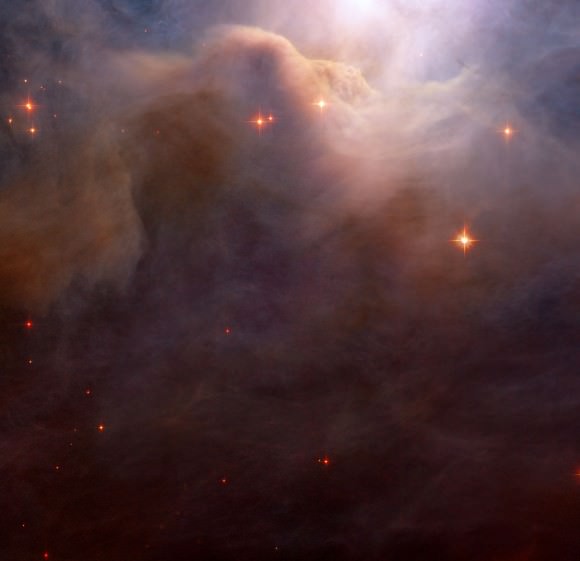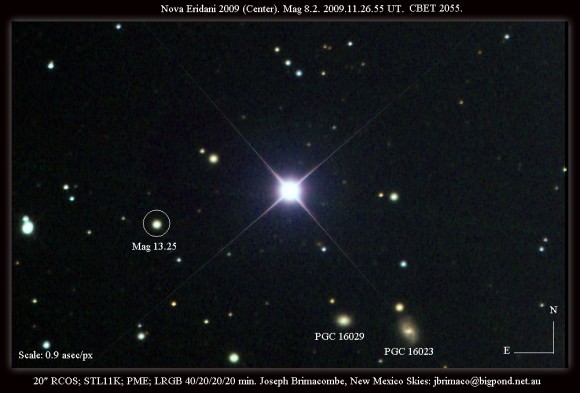ISS Temporarily Down to Crew of 2

Following today’s departure of the three man crew of Expedition 21 aboard the Soyuz TMA 15 capsule, staffing on the International Space Station (ISS) is now temporarily reduced to a skeleton crew of just 2 men for the first time since July 2006. The ISS had hosted a complete 6 person and truly international crew complement for the first time ever since its inception, starting in May of this year.
(...)
Read the rest of ISS Temporarily Down to Crew of 2 (1,032 words)
Capture A FUor!
What accretes quietly in the night and can be a blast to observe? Try a FUor… These high accretion, high luminosity phase pre-main sequence stars may only last a few decades – but display an extreme change in magnitude and spectral type in a very short period of time. While FU Orionis may be the prototype you know about, there's a lot more to learn and even more to observe! Step outside in the dark with me and let's take a look… (...)
Read the rest of Capture A FUor! (1,259 words)
Quasar Caught Building Future Home Galaxy
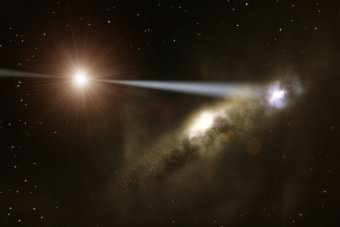
The birth of galaxies is quite a complicated affair, and little is known about whether the supermassive black holes at the center of most galaxies formed first, or if the matter in the galaxy accreted first, and formed the black hole later. Observations of the quasar HE0450-2958, which is situated outside of a galaxy, show the quasar aiding a nearby galaxy in the formation of stars. This provides evidence for the idea that supermassive black holes can 'build' their own galaxies.(...)
Read the rest of Quasar Caught Building Future Home Galaxy (475 words)
Hubble Sees Dazzling Dust in the Iris Nebula
Another gorgeous image from Hubble! This close-up of NGC 7023, or the Iris Nebula, shows an area filled with cosmic dust. Illuminated from above by the nearby star HD 200775, the dust resembles pink cotton candy, accentuated with diamond-like stars. The "cotton candy" is actually made up of tiny particles of solid matter, with sizes from ten to a hundred times smaller than those of the dust grains we find on Earth, and the "diamonds" are both background and foreground stars.
(...)
Read the rest of Hubble Sees Dazzling Dust in the Iris Nebula (109 words)
Countdown to Christmas: Hubble Advent Calendar

This is way cooler than those chocolate filled advent calendars that you can buy at the grocery store (although arguably less yummy): The Big Picture over at The Boston Globe is doing an advent calendar to count down the days until Christmas, only instead of opening a little door to nuggets of chocolate each day, you get huge chunks of Hubble eye candy!
Each day until Christmas you can feast your eyes on a new image from the Hubble Space Telescope like today's shown above. Hubble has produced enough images over its lifetime to fill a few thousand advent calendars. If you happened to be worried about your waistline this holiday season, forget buying a calorie-bloated advent calendar and head on over to The Big Picture for the next 24 images, which are sure to be stunning.
Little cycling cap tip to The Bad Astronomer
Slow-Motion Supernova
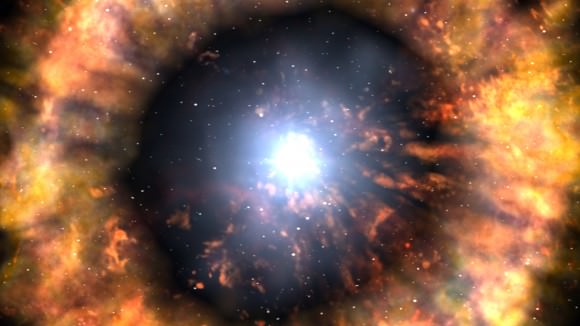
Supernovae are generally considered as fast and furious events. For the Type II, core collapse supernovae, the core implodes almost instantaneously although it takes some time for the shockwave to escape the star. As it does, the star brightens in what's known as the "rise time" of the supernova. For most Type II supernovae, this takes about a week.
So what are astronomers to make of supernova 2008iy that had an unprecedented rise time of at least 400 days?
(...)
Read the rest of Slow-Motion Supernova (426 words)
Amateur Spectroscopy

Amateur astronomers are a unique species worthy of their own reality TV show. Their craftsmanship, resourcefulness, dedication, and passion is simply amazing. Many professional astronomers rely heavily on amateurs for quick spot checks, discovery followups, collaboration on research projects, the diverse locations of their telescopes and their ability/willingness to put in long hours of observation. So what is spectroscopy, and what do the amateur astronomers get up to?
(...)
Read the rest of Amateur Spectroscopy (778 words)
The Next Generation of Heat Shield: Magnetic

Heat shields are an important part of any space vehicle that re-enters the Earth's atmosphere. The next generation of heat shields to protect astronauts and payloads on their re-entry into the Earth's atmosphere may use superconducting magnets to deflect the plasma that forms in front of spacecraft as they travel at high speeds in the air. The first test of such a heat shield could happen as early as ten years from now, and the basic technology is already in development.(...)
Read the rest of The Next Generation of Heat Shield: Magnetic (394 words)
Observing News: Nova Eridani or Flash Fire?
K. Itagaki of Yamagata, Japan was photographing the night sky in Eridanus two days ago when Hitoshi Yamaoka of Kyushu University noticed an anomaly – a possible classic nova event. Just how big a jump in amplitude did this star make? Try at least seven magnitudes within hours… and Joe Brimacombe was on it. (...)
Read the rest of Observing News: Nova Eridani or Flash Fire? (491 words)
Comets Posing as Asteroids (or is the the other way around?)

Asteroids are rocky bodies which belong between Mars and Jupiter. Comets are icy bodies that belong way out beyond Pluto. So what are comet-like objects doing in the asteroid belt?
(...)
Read the rest of Comets Posing as Asteroids (or is the the other way around?) (679 words)
Tips for Viewing the Geminid Meteor Shower
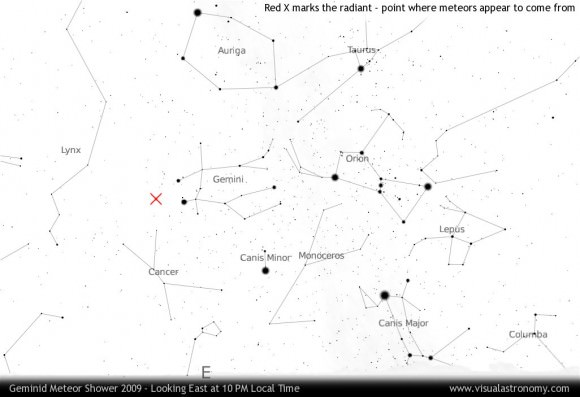
Occurring every year in mid-December, the Geminid meteor shower is commonly referred to as the most reliable meteor shower of the year. That is, it almost always puts on a great show!
The Geminid meteor shower is sure to be a stunning show this year, as the Moon will not be visible at night, so its glow will not impede your meteor viewing ability. In addition, the Geminids' radiant is favorably positioned for most viewers at this time of year. In order to see the most meteors, I suggest the following tips:
(...)
Read the rest of Tips for Viewing the Geminid Meteor Shower (559 words)
The View from Down Under
Something that baffled me throughout my childhood, growing up in Australia, was the frequent references to the Man in the Moon, in children’s books and other popular media. I just couldn’t see it.
Only in my adult years have I put two and two together and realized that all those references were made by people from the Northern Hemisphere.
South of the equator we really are down under, even in astronomical terms. All the stuff you can see in the night sky around the celestial equator and the ecliptic we can see too, but it’s all upside down (or from our point of view, right side up).
So the lunar maria you see on the Moon’s surface, we can see too, but upside down none of it looks anything like a human face.(...)
Read the rest of The View from Down Under (366 words)
Astronomers Dig Up Relic of the Milky Way's Central Bulge
Like archaeologists who dig through the layers of dirt to unearth crucial pieces of the history of mankind, astronomers have been gazing through the thick layers of interstellar dust obscuring the central bulge of the Milky Way and have unveiled an extraordinary cosmic relic. Within the bulge is an unusual mix of stars in the stellar grouping known as Terzan 5, and such a mix has never been observed anywhere in the bulge before. This peculiar conglomeration of stars suggests that Terzan 5 is one of the bulge's primordial building blocks, most likely the relic of a dwarf galaxy that merged with the Milky Way during its very early days.
(...)
Read the rest of Astronomers Dig Up Relic of the Milky Way's Central Bulge (303 words)
Jupiter – Our Silent Guardian?
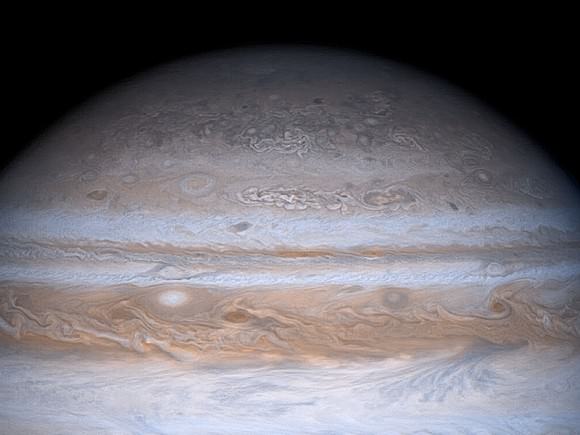
We live in a cosmic shooting gallery. In Phil Plait's Death From the Skies, he lays out the dangers of a massive impact: destructive shockwaves, tsunamis, flash fires, atmospheric darkening…. The scenario isn't pretty should a big one come our way. Fortunately, we may have a silent guardian: Jupiter.
(...)
Read the rest of Jupiter – Our Silent Guardian? (563 words)
Requiem – Daniel Marquardt
"Looking up in the sky is one of the greatest things a human being can do. Going out to a silent and dark site, enjoying the beauty of the Universe with friends. You will forget all the problems here on Earth, because you realize that we are only a little funny thing on this ball we call Earth, flying through our galaxy we call Milky Way. There is more out there that wants to be discovered. Sit back and take a journey through our real home and through space and time." And remember Daniel Marquardt… (...)
Read the rest of Requiem – Daniel Marquardt (663 words)

